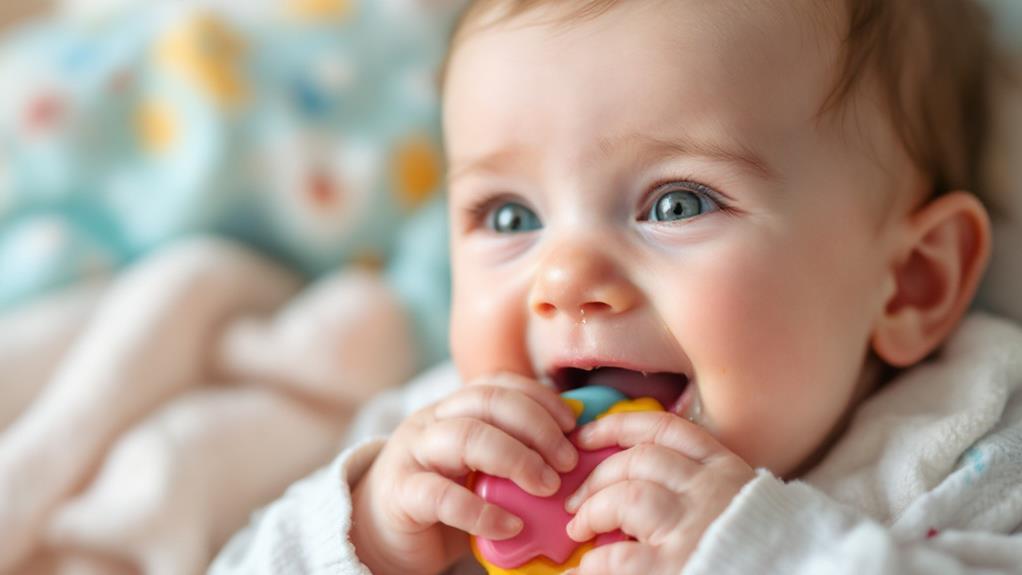How Can I Tell if My Baby Is Teething
You’ll know your baby is teething when you see some classic signs pop up. Look out for excessive drooling—the kind that can soak through outfits—and gnawing on toys or their fingers. They might be fussier than usual, clingier, or have trouble sleeping. Check those gums, too; if they’re swollen or red, that’s a giveaway. A slight rise in temperature can occur, but a high fever is a reason to call your pediatrician. Don’t worry, this teething phase is a bit of a ride. Stick around, and you’ll find some helpful tips to ease those little toothy troubles!
Common Teething Symptoms
When your baby starts teething, you might notice several common symptoms that signal the arrival of those first little teeth. One of the first signs is drooling. You may find your baby’s shirt soaked, and it’s not just from a spilled sippy cup! This extra drool helps soothe their gums, which can feel pretty uncomfortable.
You might also see your baby gnawing on toys, fingers, or anything they can reach. This is their way of relieving the pressure building up in their gums.
Sometimes, they may even fuss more than usual, which can be quite the challenge for you.
Another symptom to watch for is a slight increase in temperature. While teething can make your baby feel warm, it shouldn’t lead to a high fever. If it does, you might want to call your pediatrician.
Behavioral Changes in Babies
Teething can lead to noticeable behavioral changes in your baby. You might find that your little one is fussier than usual. It’s like they’ve entered a mini-drama phase, and you’re the audience. They may cry more often, and you could notice that they’re clingier, wanting extra cuddles and comfort.
Sometimes, your baby might seem restless, struggling to settle down for naps or bedtime. You might even see them gnawing on their toys or fingers, as if they’re part-time dentists testing out their tools! This is all part of the teething process, as their gums can feel sore and uncomfortable.
In addition, some babies may become easily frustrated or irritable, as they can’t express what they’re feeling. If your usually cheerful baby suddenly turns into a grumpy little bear, it might just be those pesky teeth making an appearance.
Physical Signs to Observe
As your baby navigates those behavioral changes, you might also notice some physical signs that indicate teething is underway. One common sign is drooling. You may find your little one leaving a puddle on their shirt, and that’s totally normal! Their gums might look swollen or red, especially where the teeth are about to break through.
Another sign to watch for is increased gum sensitivity. Your baby might chew on their fingers or toys more than usual, trying to soothe their tender gums. Sometimes, they might even fuss when you try to clean their mouth.
You might also see a change in their appetite. Some babies want to eat more, while others might push away food.
If they’re tugging at their ears or rubbing their cheeks, it could be a sign of discomfort from teething, too.
Teething Timeline and Phases
Most parents find themselves wondering about the teething timeline and phases their baby will go through.
Typically, teething starts around six months, but some little ones might begin as early as three months or as late as twelve months. You might notice the first teeth, usually the two bottom front ones, popping through first.
As your baby gets older, the process continues in phases.
Between six months to 12 months, expect those top front teeth to join the party.
Around 12 to 18 months, the molars show up, which can be a bit rough since they’re larger and can cause more discomfort.
Soothing Techniques for Teething
Finding comfort during teething can feel like an intimidating challenge for both you and your baby. But don’t worry! There are plenty of soothing techniques to help ease those little aches and pains.
One effective method is using a cold washcloth. Simply wet it, pop it in the fridge for a bit, and let your baby chew on it. The coolness can numb their gums and provide relief.
Another option is teething toys, which come in various shapes and textures. Look for ones that you can chill in the fridge—those can be especially soothing.
You might also try gently massaging your baby’s gums with a clean finger. It’s like giving them a little gum massage, which they might just love!
If you’re feeling adventurous, some parents swear by chamomile tea. A little diluted, cooled tea can be a tasty way to help calm your baby.
Finally, don’t forget the power of cuddles! Sometimes, all your baby needs is a bit of extra love and attention to feel better.
When to Consult a Pediatrician
Teething can be a challenging time for both you and your baby, but knowing when to consult a pediatrician can provide peace of mind.
If your baby’s fussiness seems extreme or lasts longer than a few days, it might be time to reach out for help. While teething can cause discomfort, it shouldn’t lead to high fever or excessive crying. If your little one has a temperature above 101°F, or if they seem unusually lethargic, don’t hesitate to call your doctor.
Also, watch for signs of dehydration. If your baby isn’t drinking enough fluids or has fewer wet diapers than usual, that’s another red flag.
And if you notice any unusual rashes or swelling, it’s best to get a professional opinion.




